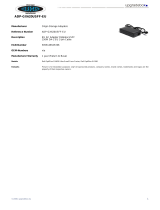
Introduction: Dell OptiPlex GX1 Low-Profile Managed PC Systems
file:///C|/infodev/2013/eDoc/OpGX1/SQRG/introduc.htm[2/21/2013 11:52:57 AM]
the three DIMM sockets on the system board. The system also supports both error checking and
correction (ECC) and nonparity DIMMs. See "Adding Memory" for details.
Self-Monitoring and Analysis Reporting Technology II (SMART II) support, which warns you at system
start-up if your hard-disk drive has become unreliable. To take advantage of this technology, you must
have a SMART II-compliant hard-disk drive in your computer. All hard-disk drives shipped with
OptiPlex GX1 systems are SMART II-compliant.
A basic input/output system (BIOS), which resides in flash memory and can be upgraded by diskette, or
remotely over a network, if required.
Full compliance with PCI specification 2.2.
Full Plug and Play version 1.0a capability, which greatly simplifies the installation of expansion cards.
Plug and Play support included in the system BIOS allows you to install Plug and Play expansion cards
without setting jumpers or switches or performing other configuration tasks. The ISA Configuration
Utility (ICU) allows you to configure existing non-Plug and Play ISA expansion cards for conflict-free
operation. Also, because the system BIOS is stored in flash memory, it can be updated to support
future enhancements to the Plug and Play standard.
Wakeup On LAN capability, which, when enabled in the System Setup program, allows the system to
be powered up from a server management console. Wakeup On LAN capability also allows remote
computer setup, software downloading and installation, file updates, and asset tracking after hours and
on weekends when network traffic is at a minimum. For more information, refer to "Using the System
Setup Program."
Universal Serial Bus (USB) capability, which can simplify connecting peripheral devices such as mice,
printers, and computer speakers. The USB connectors on your computer's back panel, which are
enabled by default, provide a single connection point for multiple USB-compliant devices. USB-
compliant devices can also be connected and disconnected while the system is running.
A modular computer chassis with a minimum number of screws for easy disassembly and improved
serviceability.
Hardware Features
The system board includes the following integrated features:
Three expansion slots on a riser board with one 32-bit PCI slot, one 16-bit ISA slot, and one shared
PCI/ISA slot.
A 64-bit accelerated graphics port (AGP) video subsystem, which includes the ATI 3D Rage Pro super
video graphics array (SVGA) video controller. This video subsystem contains 4 MB (upgradable to 8
MB) of synchronous graphics random-access memory (SGRAM) video memory. Maximum resolutions
are 1600 × 1200 with 65,536 colors noninterlaced and 1280 × 1024 and 1024 × 768 with true-colors
noninterlaced. In 800 × 600 and 640 × 480 resolutions, 16.7 million colors are available for true-color
graphics using a 32-bits per pixel (bpp) format. True-color provides higher performance, but uses more
graphics memory. Table 1 lists the video memory requirements for the Microsoft Windows® 95,
Windows 98, and Windows NT 4.0 operating systems.
Table 1. Video Memory Requirements
Video Resolution Maximum Color
Depth
Maximum Refresh
Rate
Minimum SGRAM
Required
640 × 480 True-color (32 bpp) 85 Hz 4 MB
800 × 600 True-color (32 bpp) 85 Hz 4 MB





















